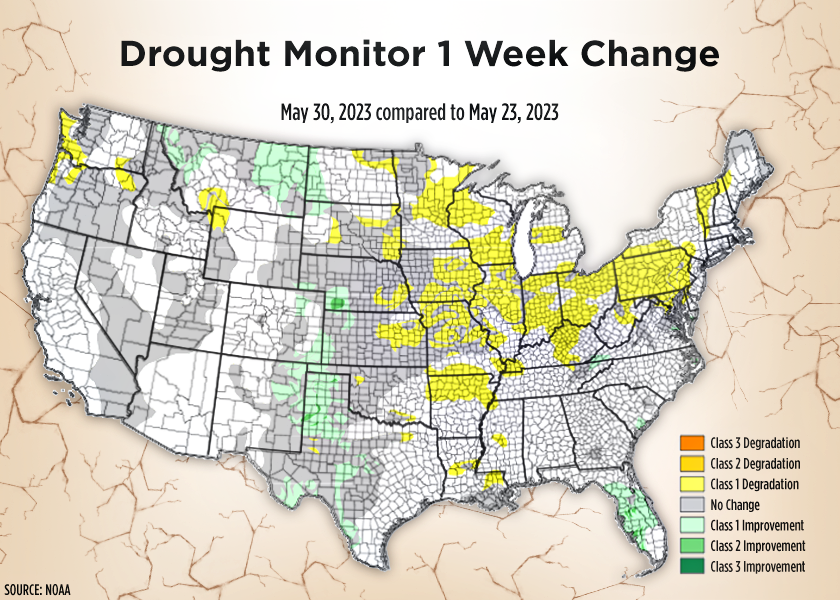
The latest U.S. Drought Monitor paints two very different pictures across the country: A remarkable recovery in drought across the Plains versus declining conditions in the Midwest, as drought expands its grip and moves into the East. Farmers in Corn Belt states are concerned about the impact on crop conditions, especially in areas where the subsoil moisture has been depleted over the past year.
USDA Meteorologist Brad Rippey, who helps author the drought monitor, says the changes in the map over the past four weeks show the story best, with some major improvements across the Plains and with deepening drought in the Midwest.
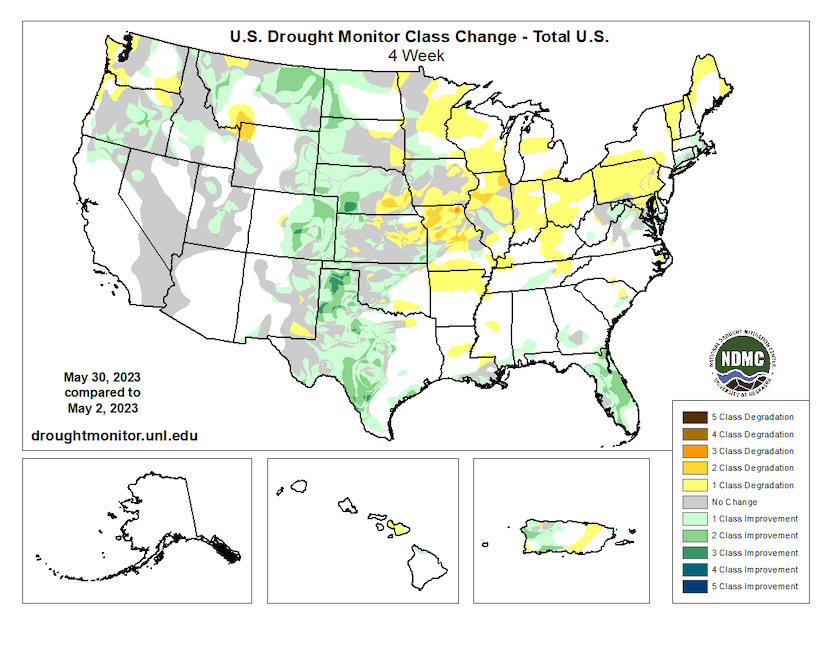
While several areas in the central Corn Belt are experiencing drought, the dryness has been parked in the western Corn Belt longer, Rippey says, which is a key factor when you consider soil moisture and now short-term dryness compounding with the longer-term drought situation.
“The drier areas west of the Mississippi include Nebraska and western Iowa; those areas have been dry much longer,” Rippey says. “You see a dry signal in those areas going back up to a year or more.”
Communities around Omaha and Lincoln, Neb., and into western Iowa, have been running out of water, which is a reflection of the longer-term drought picture.
“This spring, we have had short-term drought on top of that long-term drought, so we’re seeing a big array of problems, everything from browning pastures to stress on emerging summer crops,” Rippey says.
It’s dry, but dang we got roots! pic.twitter.com/ye2XHlNuMv
— Corn Junkie (@SchwabMatt) June 1, 2023
East of the Mississippi, in states such as Illinois, Indiana, Michigan and Ohio, Rippey says farmers are seeing a short-term dry signal.
“We still have plenty of subsoil moisture. If we get the crops emerged and established, those roots should be able to reach down into that subsoil moisture. But for the time being, it’s extremely dry on the surface. Just a few weeks of dryness has depleted that upper level of soil moisture, which makes it tough to get the crop evenly emerged and established,” Rippey says. “If we can just get a little bit of rain in the next few weeks that should help the crops, and then get the crops into that deeper soil moisture.”
🔥 US Drought Monitor ☔
Grain Production Areas Experiencing Drought (+/- weekly change)
🌽Corn: 34% (+8%)
☁️Cotton: 28% (-8%)
🌾Sorghum: 71% (-3%)
🌱Soybeans: 28% (+8%)
🌾Spring Wheat: 6% (-2%)
🌾Winter Wheat: 46%… pic.twitter.com/lvU1hZJX9g— GrainStats.com 🌾 (@GrainStats) June 1, 2023
USDA shows 34% of the corn crop is currently in drought, and 28% of the soybean crop is experiencing drought conditions. With little to no rain in the forecast, it could impact crop conditions.
“Certainly in the short-term, we’ve got that blocking high in place over the Midwest up into eastern Canada, which is keeping the moisture out. We’ve seen a few showers break out west of the Mississippi, but at least for the next seven to 10 days it looks bone dry for the eastern Corn Belt. The flash drought will continue to evolve, likely making that transition from abnormal dryness into the lower drought categories over the next week or two unless we see an unexpected change.”
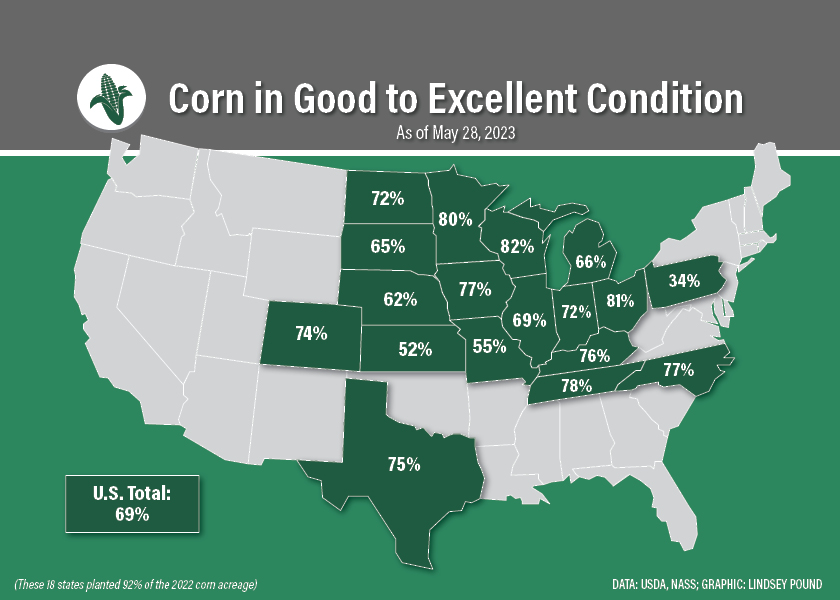
U.S. corn crop conditions are currently better than a year ago. USDA is now including condition ratings in its Crop Progress report, and the figures released by USDA-NASS on Tuesday showed 73% of the corn crop is rated good to excellent versus 69% the same time last year.
The Other Extreme
While shades of yellow and orange expand over the Corn Belt signaling drought is intensifying, areas in Texas, Oklahoma and Kansas are seeing improvement. Some parts of Texas recorded the wettest May on record, which is prompting planting delays.
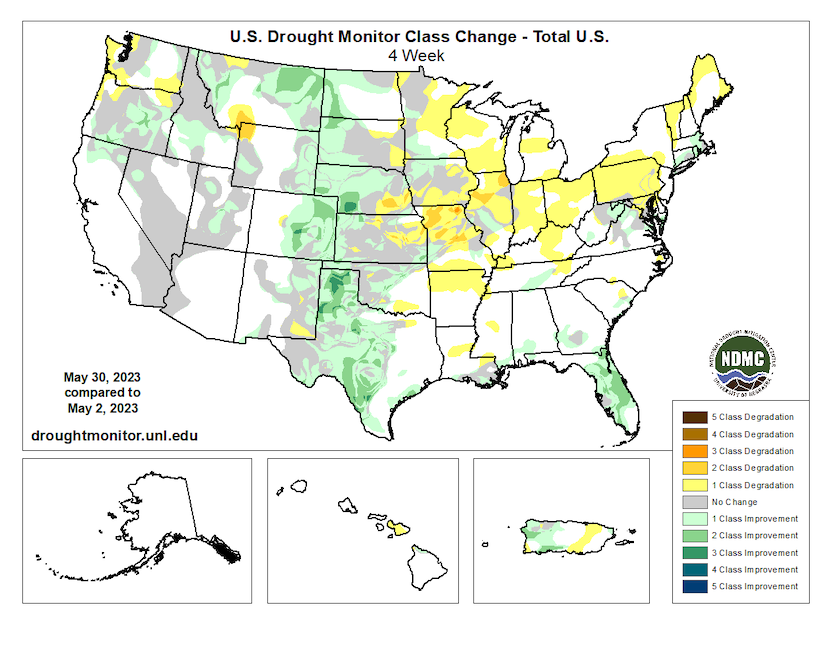
“Some areas in the High Plains region, from southwestern Nebraska to Texas, picked up more than 10 inches of rain in a few locations,” Rippey says. “It was the wettest May on record. We went from D3 and D4 extremes to exceptional drought to flash flooding and planting delays in a period of three to four weeks, which is truly remarkable change,” he adds.
A Texas highway was hit with severe flash flooding due to heavy rainfall, washing away vehicles and leaving some roads closed across the Texas panhandle pic.twitter.com/TZ0vlCSrle
— Reuters (@Reuters) June 2, 2023
More rain is in the forecast for the southern Plains, which will further delay planting. [AG Web, JSOnline]
FUNDRAISING: KEEP STRANGESOUNDS ONLINE!… THANK YOU FOR YOUR HELP! You can give through Credit cards, Debit cards and Paypal by using the form below. (You will get a gemstone gift for every donation above 50$! Send me your snail mail per e-mail)
You should also join my newsletter…YOU WILL LOVE IT…
Some products I recommend you to add to your preparedness plan to help and protect you and your family during an emergency:
- Protect your home and car with the best lightning and EMP protection available…
- Always filter your water at home: Use this filter to drink clean water at home!
- Health Ranger Store: Stock up on preparedness food and products to be ready for the next emergency disaster…
I recommend following Qfiles for videos, podcasts and a wide compilation of alternative news…



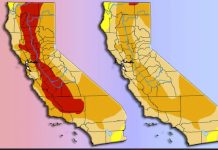
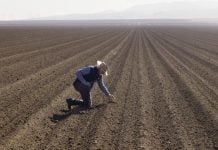
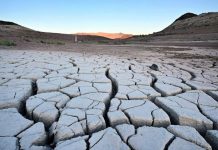

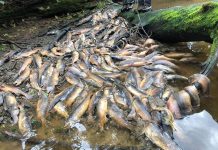
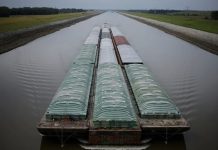

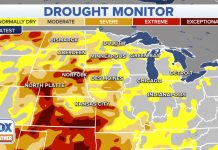
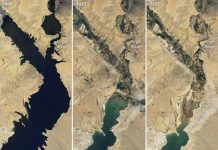

Poor Americans will starve/are starving. Impossible to be “the greatest country in the world” with tribes in filthy and unhealthy reservations, the HOA imprisoning homeowners for not mowing their lawn, CPS kidnapping and medically trafficking children whose parents even slightly disagree with their agendas, etc. Look up the Patriot Act and the Anti-Tiktok bills. And children are coerced in all 50 states’ schools into pledging allegiance to a cloth. Complete idolatry and blasphemy.